 I’m delighted to welcome Amy Maroney back to the blog to talk about being in ‘Exile’. Amy studied English Literature at Boston University and worked for many years as a writer and editor of nonfiction. She lives in Oregon, U.S.A. with her family. When she’s not diving down research rabbit holes, she enjoys hiking, dancing, traveling, and reading. I’m delighted to welcome Amy Maroney back to the blog to talk about being in ‘Exile’. Amy studied English Literature at Boston University and worked for many years as a writer and editor of nonfiction. She lives in Oregon, U.S.A. with her family. When she’s not diving down research rabbit holes, she enjoys hiking, dancing, traveling, and reading.
Amy is the author of The Miramonde Series, an award-winning historical fiction trilogy about a Renaissance-era female artist and the modern-day scholar on her trail. Her new historical suspense series, Sea and Stone Chronicles, is set in medieval Rhodes and Cyprus.
Amy is one of the contributors to the recently released Historical Stories of Exile. She knows a thing or two about writing captivating and lyrical historical fiction! Let yourself be entranced by a queen’s story of mistrust, exile and hope.
As is often the case with women in history, very little is known about the medieval Queen Charlotta of Cyprus (she is also known as ‘Charlotte’ and ‘Carlotta’). Born around 1444, Charlotta was the only surviving child of King Jean II of Lusignan and his wife Eleni Palaeologina, princess of Morea.
King Jean was a genial and ineffective ruler who loved hunting, hawking, and entertaining. The French Lusignan dynasty’s glory days had ended with his grandfather King Janus and grandmother Queen Charlotte I. By Jean’s era, three centuries of lavish living coupled with a weak military presence had taken a drastic toll. The Genoese seized control of the main port city, Famagusta; the Mamluks of Egypt only paused their attacks on Cyprus thanks to tribute payments to their sultan; and the Venetians underwrote many of King Jean’s expenses, miring the kingdom in crippling debt.
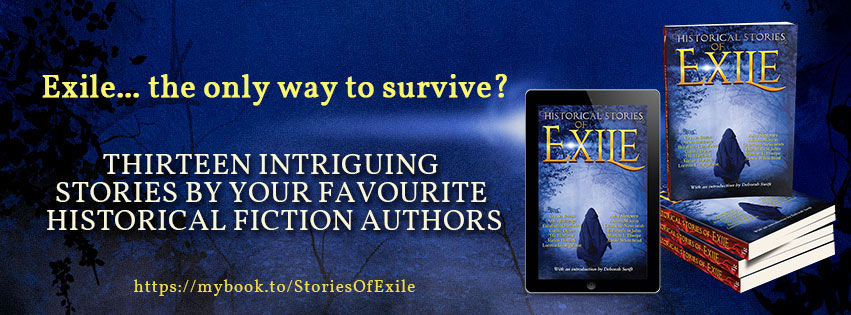
Meanwhile, animosity simmered within the court. Queen Eleni was a proud Greek and a dominating personality. She purportedly bit (or cut off) her rival Marietta’s nose when she found the woman in bed with her husband. Jean and Marietta’s son, Jacques (also known as Jacco the Bastard) was a handsome, charismatic bully with a thirst for power.
Princess Charlotta lived with her mother and various Greek attendants; her understanding of French was rudimentary at best. At about 13, she was married to Prince João of Coimbra (Portugal). The young couple moved from the royal palace to a house elsewhere in the Cyprus capital of Nicosia, angering Queen Eleni.
Tensions grew until Prince João died under mysterious circumstances; the queen’s chamberlain was blamed. In a royal tit-for-tat, the queen’s chamberlain was then murdered. Palace gossips said Charlotta had asked Jacco to arrange the killing.
Before he could be punished, Jacco fled for the island of Rhodes and the hospitality of the Knights Hospitaller. Meanwhile, Charlotta grieved her dead husband and awaited a new betrothal, this time with her first cousin Louis of Savoy.
Queen Eleni fought the betrothal fiercely, for in the Greek Orthodox tradition, marrying a first cousin was an unforgivable sin. In 1458, both Queen Eleni and King Jean died. Charlotta became queen, though she’d had no training for the job.
Jacco sailed to Egypt and charmed the Mamluk Sultanate; by the time Charlotta married Louis of Savoy, a groundswell of popular support for Jacco as king was sweeping over the island of Cyprus.
The powerful barons who had served her father as council members now whispered in Charlotta’s ear. Her husband Louis proved to be a weak leader. When Charlotta was 16, she moved her court into the massive coastal fortress of Kyrenia, bracing for a siege.
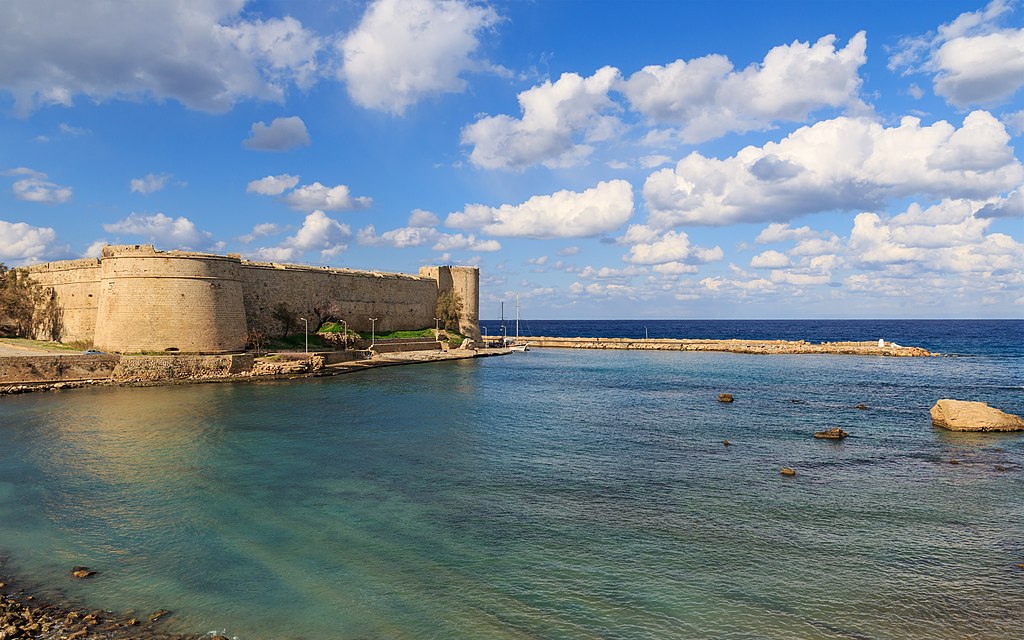 Kyrenia Castle in Cyprus, where Charlotta was blockaded for three years (Photo A.Savin, WikiCommons) Jacco and his army of Mamluk warriors sailed to Cyprus in 1460, determined to seize power. Unfortunately, Charlotta’s husband, Louis, was more interested in finding a source for his beloved milk-fed veal than making plans for war.
The fate of the kingdom of Cyprus balanced on a knife-point, and Charlotta took it upon herself to save the day. She begged allies all over the West to help fund her war chest. She readied the fortress of Kyrenia for a siege. She ransomed her own jewelry and her kingdom’s treasures, desperate to keep her throne.
When all seemed lost, she set sail on the Mediterranean Sea, traveling through wind and waves in search of aid, pleading with men of power for help.
The story I wrote for the Exile anthology captures a critical moment near the end of her reign, when Queen Charlotta asks her allies the Knights Hospitaller to give her wise counsel. Then, when all seems lost, she heads back to sea for one last-ditch effort to preserve her throne—no matter the cost.
———
Connect with Amy
Website: https://www.amymaroney.com/
Twitter: twitter.com/wilaroney
Facebook: www.facebook.com/amymaroneyauthor
Instagram: www.instagram.com/amymaroneywrites/
Pinterest: pinterest.com/amyloveshistory/
Book Bub: www.bookbub.com/profile/amy-maroney
Amazon Author Page: author.to/AmyMaroneyAmazonPage
Goodreads: www.goodreads.com/author/show/15831603.Amy_Maroney
———
Read Amy’s latest story in the Sea and Stone Chronicles.
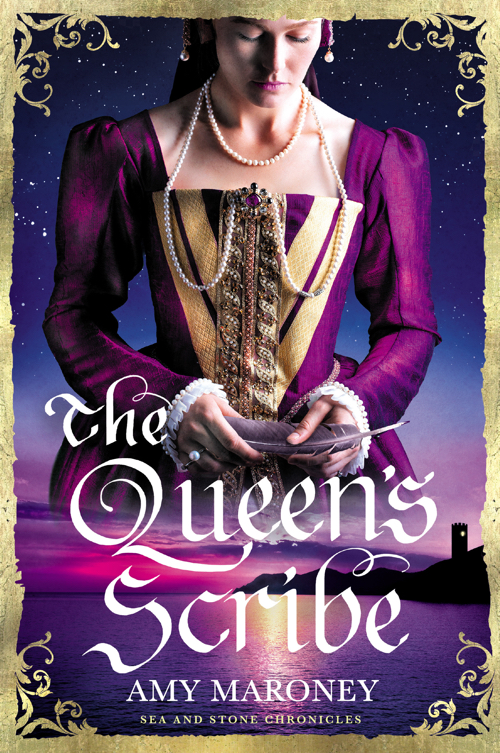 The Queen’s Scribe The Queen’s Scribe
A broken promise. A bitter conflict. And a woman’s elusive chance to love or die.
1458. Young Frenchwoman Estelle de Montavon sails to Cyprus imagining a bright future as tutor to a princess. Instead, she is betrayed by those she loves most—and forced into a dangerous new world of scheming courtiers, vicious power struggles, and the terrifying threat of war.
Determined to flee, Estelle enlists the help of an attractive and mysterious falconer. But on the eve of her escape, fortune’s wheel turns again. She gains entry to Queen Charlotta’s inner circle as a trusted scribe and interpreter, fighting her way to dizzying heights of influence.
Enemies old and new rise from the shadows as Estelle navigates a royal game of cat and mouse between the queen and her powerful half-brother, who wants the throne for himself.
When war comes to the island, she faces a brutal reckoning for her loyalty to the queen. Will the impossible choice looming ahead be Estelle’s doom—or her salvation?
With this richly-told story of courage, loyalty, and the sustaining power of love, Amy Maroney brings a mesmerising and forgotten world to vivid life. The Queen’s Scribe is a stand-alone novel in the Sea and Stone Chronicles collection.
Buy Amy’s book here: https://mybook.to/QueensScribe (Goes to your local Amazon store and other retailers) and is also available on Kindle Unlimited.
Alison Morton is the author of Roma Nova thrillers – INCEPTIO, CARINA (novella), PERFIDITAS, SUCCESSIO, AURELIA, NEXUS (novella), INSURRECTIO and RETALIO, and ROMA NOVA EXTRA, a collection of short stories. Audiobooks are available for four of the series. Double Identity, a contemporary conspiracy, starts a new series of thrillers. JULIA PRIMA, Roma Nova story set in the late 4th century, starts the Foundation stories. The sequel, EXSILIUM, will be out in January 2024.
Find out more about Roma Nova, its origins, stories and heroines and taste world the latest contemporary thriller Double Identity… Download ‘Welcome to Alison Morton’s Thriller Worlds’, a FREE eBook, as a thank you gift when you sign up to Alison’s monthly email update. You’ll also be among the first to know about news and book progress before everybody else, and take part in giveaways.
If you enjoyed this post, do share it with your friends!Like this:Like Loading...
 I’m delighted to welcome Anna Belfrage back to the blog, this time to talk about her short story, The Unwanted Prince. Had Anna been allowed to choose, she’d have become a time-traveller. As this was impossible, she became a financial professional with three absorbing interests: history, romance and writing. Anna always writes about love and has authored the acclaimed time travelling series The Graham Saga, set in 17th century Scotland and Maryland, as well as the equally acclaimed medieval series The King’s Greatest Enemy set in 14th century England. I’m delighted to welcome Anna Belfrage back to the blog, this time to talk about her short story, The Unwanted Prince. Had Anna been allowed to choose, she’d have become a time-traveller. As this was impossible, she became a financial professional with three absorbing interests: history, romance and writing. Anna always writes about love and has authored the acclaimed time travelling series The Graham Saga, set in 17th century Scotland and Maryland, as well as the equally acclaimed medieval series The King’s Greatest Enemy set in 14th century England.
More recently, she has published Her Castilian Heart, the third in her medieval The Castilian series set against the conquest of Wales. She has just released Times of Turmoil, the sequel to her 2021 historical fiction/time travel romance, The Whirlpools of Time.
Anna is one of the contributors to the recently released Historical Stories of Exile. She knows a thing or two about writing captivating historical fiction! Let yourself be entranced by a poignant story of heartache and exile.
I have some historical periods I steer clear of.
Correction: I have some historical periods I used to stay clear of, because one of those periods is the 16th century—I am no fan of the Tudors—but there I was, considering just what to write about for the short story collection Historical Stories of Exile and who wormed his way into my head? A little 16th century prince. A real prince, by the way, not some invented character.

“Real prince?” My protagonist’s uncle—Johan III of Sweden—scoffs loudly. “How can you even call him that? His mother was the illiterate daughter of a sergeant!”
True, that, and the hoity-toity Swedish nobility never let little Karin forget just how lowborn and insignificant she was.
“Well, she was—is,” Johan says. “Not like my wife.” He beams at his lady—and I forgive Johan a lot for his constant affection for his Polish princess, Katarina Jagellonica. She was well past the first blush of youth when they met, but Johan knew a gem when he saw one, and these two very intelligent and well-educated peeps developed a strong and, by all accounts, good marriage. Even when they were locked up for years by Johan’s brother, Erik XIV. (Because Johan, naughty boy that he was, snuck off to marry Katarina without big brother’s permission. And Erik did NOT like that Johan ended up with a wife of such impeccable lineage as Katarina’s)
By now, I am thinking you’ve caught on to the fact that Erik and Johan weren’t exactly the closest of brothers. That’s what happens when Daddy (Gustav I of Sweden) instils ambition as one of the most important qualities a royal prince should have. If there’s just one kingdom, just one throne, it follows that all brothers will set their sight on the same prize, right?
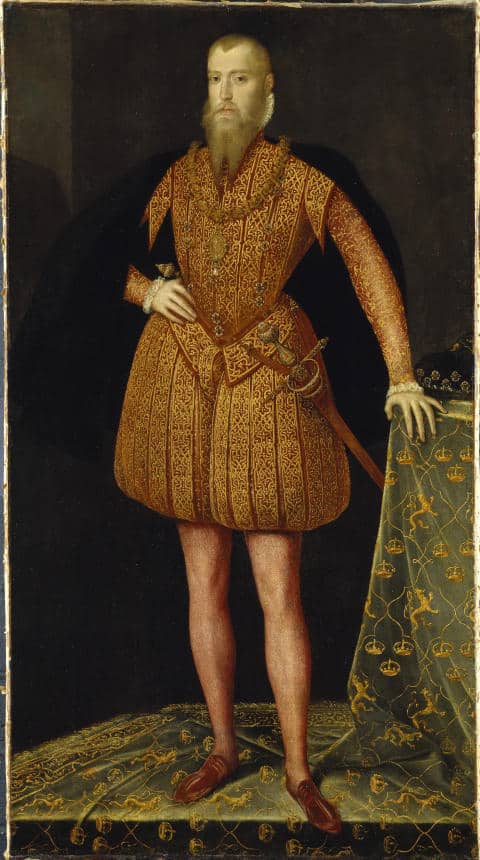 Erik of Sweden – courting portrait But Erik was firstborn, which is why he became king. Erik was handsome, a great dancer, witty, well-educated and quite convinced he was the best thing since sliced bread. He never understood how Elizabeth of England could turn him down, especially not given the absolutely gorgeous portrait of himself he sent her.
Erik was determined to marry for dynastic reasons—yet another of Daddy’s lessons. But the moment he met Karin Månsdotter, all sense flew out of him. Well, so said his brothers and his nobles. Erik, however, was entranced by this young girl, who was so soothing to be with.
Being anything but a fool, Erik at first installed Karin as his mistress. He was still planning on marrying an adequate princess with whom to beget an heir. But time passed and Karin presented him with a daughter and a son, so he began reconsidering. Plus, there was also the fact that Erik was . . . erm . . . somewhat unstable—and prone to see conspiracies behind every tapestry adorning his castles.
When he formally wed Karin, legitimised his children—three huzzahs for little Prince Gustav!—and had Karin crowned as his queen, every single one of his nobles concluded he’d gone bonkers. Not entirely untrue, unfortunately, because Erik was afflicted by bouts of madness. While under the grip of one such attack, our Erik stormed off to where he was holding some members of the Sture family captive and murdered them by his own hand. The Sture family was one of the most prominent in Sweden—which was why Erik had locked father and son up, suspicious they might want to retake a throne they had as much right to as he did.
This heinous act shocked Sweden. It also gave Johan (who had, in fact, been conspiring behind the tapestries) the perfect excuse to usurp the throne. Erik was bundled off to captivity, and with him went his wife and their children. At first.
 1864 painting of Karin by Erik Johan Löfgren Years of being moved from one castle to the other—a living ex-king was a dangerous threat to the new king—ended for Karin and her children when, one day, they were forcibly removed from Erik’s presence and sent off to Finland. Karin had been given land there, and with the Baltic sea between them, Johan didn’t have to see his parvenue sister-in-law, or her children. Except of course that if Erik was a threat, well, then so was little Gustav, and Johan had his own son, Sigismund, to protect.
What happens to little Gustav, I leave for you to discover in Historical Stories of Exile. And as to Erik XIV, some years after having been separated from his Karin, he died. Just like that. Or not, as it turned out, because someone had laced his pea-soup with a very, very deadly dose of arsenic. And yes, I believe we can safely assume it was done on brother Johan’s orders!
And they say Romans were the arch conspirators!
Find out more about Erik XIV: https://www.annabelfrage.com/2014/02/08/the-jilted-suitor/
About Johan III and Katarina? (and Tsar Ivan. Quite the triangle, that . . .): https://www.annabelfrage.com/2020/07/10/princess-wife-prisoner-and-would-be-hostage/
———-
Connect with Anna
Website: www.annabelfrage.com
Twitter: https://twitter.com/abelfrageauthor
Bluesky: https://bsky.app/profile/abelfrageauthor.bsky.social
Facebook: https://www.facebook.com/annabelfrageauthor
Instagram: https://instagram.com/annabelfrageauthor
Book Bub: https://www.bookbub.com/profile/anna-belfrage
———
Read Anna’s latest book (yet another story set in a time she never, ever intended to write about, namely the 18th century)
Times of Turmoil
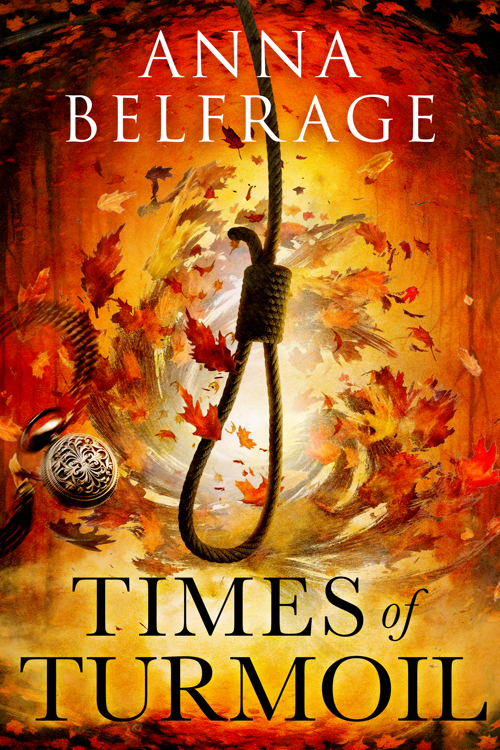 1718, and Duncan Melville and his time traveller wife, Erin, are concentrating on building a peaceful existence for themselves and their twin daughters. Difficult to do, when they are beleaguered by enemies. 1718, and Duncan Melville and his time traveller wife, Erin, are concentrating on building a peaceful existence for themselves and their twin daughters. Difficult to do, when they are beleaguered by enemies.
Erin Melville is not about to stand to the side and watch as a child is abused—which is how she makes deadly enemies of Hyland Nelson and his family.
Then there’s that ghost from their past, Armand Joseph Chardon, a person they were certain was dead. Apparently not. Monsieur Chardon wants revenge and his sons are tasked with making Duncan—and his wife—pay.
Things aren’t helped by the arrival of Duncan’s cousin, fleeing her abusive husband. Or the reappearance of Nicholas Farrell in their lives, as much of a warped bully now as he was when he almost beat Duncan to death years ago. Plus, their safety is constantly threatened as Erin is a woman of colour in a time and place where that could mean ostracism, enslavement or even death.
Will Duncan and Erin ever achieve their simple wish – to live and love free from fear of those who wish to destroy them?
Buy Times of Turmoil here: https://myBook.to/ToTABG (Goes to your local Amazon store and other retailers) and is also available on Kindle Unlimited.
Alison Morton is the author of Roma Nova thrillers – INCEPTIO, CARINA (novella), PERFIDITAS, SUCCESSIO, AURELIA, NEXUS (novella), INSURRECTIO and RETALIO, and ROMA NOVA EXTRA, a collection of short stories. Audiobooks are available for four of the series. Double Identity, a contemporary conspiracy, starts a new series of thrillers. JULIA PRIMA, Roma Nova story set in the late 4th century, starts the Foundation stories. The sequel, EXSILIUM, will be out in January 2024.
Find out more about Roma Nova, its origins, stories and heroines and taste world the latest contemporary thriller Double Identity… Download ‘Welcome to Alison Morton’s Thriller Worlds’, a FREE eBook, as a thank you gift when you sign up to Alison’s monthly email update. You’ll also be among the first to know about news and book progress before everybody else, and take part in giveaways.
If you enjoyed this post, do share it with your friends!Like this:Like Loading...
 Today I’m delighted to welcome Marian L Thorpe to my blog today. Taught to read at the age of three, words have been central to Marian’s life for as long as she can remember. A novelist, poet, and essayist, Marian has several degrees, none of which are related to writing. After two careers as a research scientist and an educator, she retired from salaried work and returned to writing things that weren’t research papers or reports. Today I’m delighted to welcome Marian L Thorpe to my blog today. Taught to read at the age of three, words have been central to Marian’s life for as long as she can remember. A novelist, poet, and essayist, Marian has several degrees, none of which are related to writing. After two careers as a research scientist and an educator, she retired from salaried work and returned to writing things that weren’t research papers or reports.
Her first published work was poetry, in small journals; her first novel was released in 2015. Empire’s Daughter is the first in the Empire’s Legacy series: second-world historical fiction, devoid of magic or other-worldly creatures and based to some extent on northern Europe after the decline of Rome. In addition to her novels, Marian has read poetry, short stories, and non-fiction work at writers’ festivals and other juried venues.
Marian’s other two passions in life are birding and landscape history, both of which are reflected in her books. Birding has taken her and her husband to all seven continents, but these days she’s mostly content to move between Canada and the UK.
Marian has contributed an evocative story featuring Olai the Northman, a story of loyalty and love for a falcon, to the recently released Historical Stories of Exile.

The gyrfalcon, largest of the falcon family, is a bird of the Arctic – and a bird highly valued in medieval falconry across Europe and Asia. Not only are they large enough to take down a swan or a crane, but in the white form, they are exceptional beautiful bird. Their hunting prowess, their size and beauty, and the great difficulty in obtaining them from the Arctic cliffs where they nest meant they were a falcon fit only for a king or emperor. Throughout the medieval period, gyrfalcons were often presented as gifts from one royal to another, and the gift that frames my story On Shining Wings is one of historical record. About 1225, Haakon IV of Norway sent hunters on a two-year expedition to Iceland to catch gyrfalcons for Henry III of England. The hunters brought back back three white and ten grey gyrfalcons, which, as Haakon explained in a letter to Henry, the extreme cold and difficulty of the expedition made these birds more precious than gold or silver.[i]
Nowhere (at least that I could find!) is it recorded who brought the birds from Norway to England, but it seemed reasonable to me that one of the men who’d captured the birds might be sent along to care for them on the voyage. After all, they’d been caring for them for two years and must have been both skilled in their feeding and maintenance, and, I would think, have grown attached to the birds. Olai, my character, is completely fictional—but he could well have existed.

Olai’s descent down the cliff to capture the fledgling gyrfalcons may or may not be how these birds were captured: I based it on stories from a work colleague, who had grown up in the Faroes in the 1950s and had used the described technique to take seabird eggs and chicks from the cliffs. But other than that imaginative recreation, almost all the rest of Olai’s duties are based on historical record. When he says that his lord de Hauville is paid more to feed the birds each day than he receives as a groom for the falcons, that’s based on, the records of the Exchequer, which records the wages of a groom as 1 ½ d a day in this period.[ii]
Olai’s lord de Hauville is an amalgam of real characters: the de Hauvilles were chief among the royal falconers during the early part of Henry III’s reign (and with sole care of the gyrfalcons); the de Hauville estate in Northamptonshire was one of their properties where birds were kept. But I couldn’t determine exactly which de Hauville – so he goes unnamed, reasonable since his mews groom Olai would almost certainly not think of him as anything but his lord.
The story Olai tells to his grandson within On Shining Wings is imaginative, based on my own love of the fenlands and washlands of East Anglia (an area favoured by Henry III for hunting heron and cranes) and forty-five years of birding (in which I’ve seen only one gyrfalcon in the wild). But it’s plausible – I hope!
[i] Thierry Buquet. The Gyrfalcon in the Middle Ages, an Exotic Bird of Prey (Western Europe and
Near East). Burnett, Charles; Van Den Abeele, Baudouin. Falconry in the Mediterranean Context During the Pre-Modern Era, 9, Droz, pp.79-98, 2021, Bibliotheca Cynegetica, 978-2-600-06236-7.
[ii] Robin S. Oggins. The Kings and Their Hawks: Falconry in Medieval England. Yale University Press, 2005.
———-
Connect with Marian
Website: www.marianlthorpe.com
Facebook: https://www.facebook.com/marian.thorpe.1
BlueSky: @marianlthorpe.bsky.social
———-
Read Marian’s novel:
Empress & Soldier
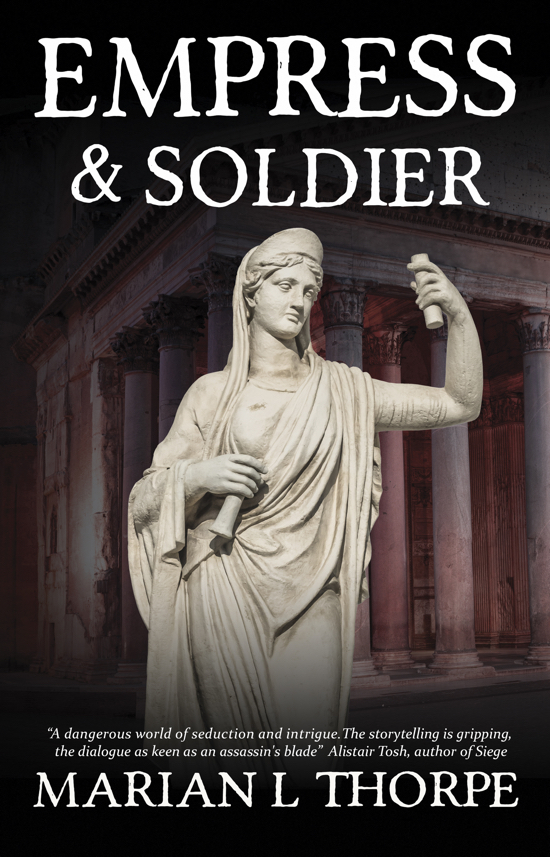 A boy of the night-time streets. A girl of libraries and learning.
Druisius, the son of a merchant, is sixteen when an order from his father that he can neither forgive nor forget drives him from home and into the danger and intrigue of the military.
Eudekia, a scholar’s daughter, educated and dutiful, is not meant to be a prince’s bride. In an empire at war, and in a city beset by famine and unrest, she must prove herself worthy of its throne.
A decade after a first, brief meeting, their lives intersect again. When a delegation arrives from the lost West, asking Eudekia for sanctuary for a princess and support for a desperate war, Druisius is assigned to guard them. In the span of a few weeks, a young captain will capture the hearts of both Empress and soldier in very different ways, offering a future neither could have foreseen.
A stand-alone novel that can also serve as a second entry point into the Empire’s Legacy series.
Buy Marian’s book here: https://books2read.com/b/empressandsoldier (Goes to your local Amazon store and other retailers)
Alison Morton is the author of Roma Nova thrillers – INCEPTIO, CARINA (novella), PERFIDITAS, SUCCESSIO, AURELIA, NEXUS (novella), INSURRECTIO and RETALIO, and ROMA NOVA EXTRA, a collection of short stories. Audiobooks are available for four of the series. Double Identity, a contemporary conspiracy, starts a new series of thrillers. JULIA PRIMA, Roma Nova story set in the late 4th century, starts the Foundation stories. The sequel, EXSILIUM, will be out in January 2024.
Find out more about Roma Nova, its origins, stories and heroines and taste world the latest contemporary thriller Double Identity… Download ‘Welcome to Alison Morton’s Thriller Worlds’, a FREE eBook, as a thank you gift when you sign up to Alison’s monthly email update. You’ll also be among the first to know about news and book progress before everybody else, and take part in giveaways.
If you enjoyed this post, do share it with your friends!Like this:Like Loading...
 I’m delighted to welcome Annie Whitehead to the blog to talk about being in Exile. She’s a prize-winning writer, historian, and elected Fellow of the Royal Historical Society, and has written four award-winning novels set in ‘Anglo-Saxon’ Mercia, including To Be A Queen, the story of Æthelflæd, Lady of the Mercians. I’m delighted to welcome Annie Whitehead to the blog to talk about being in Exile. She’s a prize-winning writer, historian, and elected Fellow of the Royal Historical Society, and has written four award-winning novels set in ‘Anglo-Saxon’ Mercia, including To Be A Queen, the story of Æthelflæd, Lady of the Mercians.
She’s contributed to fiction and nonfiction anthologies and written for various magazines and was the winner of the inaugural Historical Writers’ Association/Dorothy Dunnett Prize 2017 and is now a judge for that same competition. Among her credits are as judge for the Historical Novel Society Short Story Competition, twice a prize winner in the Mail on Sunday Novel Writing Competition, First Prize in the 2012 New Writer Magazine’s Prose and Poetry Competition. She’s also been a finalist in the Tom Howard Prize for non-fiction, and shortlisted for the Exeter Story Prize and Trisha Ashley Award 2021.
Her nonfiction books, Mercia: The Rise and Fall of a Kingdom and Women of Power in Anglo-Saxon England, are published by Amberley Books and Pen & Sword Books. Added to her recent rcontribution to a new history of English monarchs, published by Hodder & Stoughton in 2023, she’s currently writing a book on Murder in Anglo-Saxon England, to be published by Amberley in 2024.
Annie is the first of my author guests who are fellow contributors to the recently released Historical Stories of Exile. She knows a thing or two about the Anglo-Saxon period in England! Let yourself be entranced by romance, the force of history, heartache and exile.
The world of the Anglo-Saxons is probably less familiar than some periods of history, though The Last Kingdom has helped to popularise it. Even those who don’t know much about the period will have heard of 1066, and we all know that in that year Anglo-Saxon England became Anglo-Norman. We also know the key players: Harald Hardrada of Norway, William of Normandy, Harold Godwineson of England – and poor Edith Swanneck, who identified Harold’s body after the battle of Hastings.
Harold and Edith’s tale is romantic, poignant, heart-wrenching. She was, seemingly, his soulmate, his handfast woman, and she alone, apparently, could identify him because of secret markings on his body that only she was familiar with.
Yet she was not his wife. That title belonged to another woman, another Edith (actually Edith Swanneck’s name wasn’t Edith, it was Eadgifu, but let’s not complicate matters!) but Edith in Old English is spelled Ealdgyth, and that’s the name I’ve gone with in my story about her for ‘Exile’.

1066 might be the one date that sticks in everyone’s mind, but Lady Godiva is surely the one figure from Anglo-Saxon history whom everyone has heard of. She might not have ridden naked through the streets of Coventry as per the legend, but she was certainly a real person. Rich, famous, and influential, she was part of a huge family with political power in the Midlands, a family which included King Cnut’s first wife, Ælfgifu of Northampton, who ruled Norway on behalf of their son. The family’s matriarch was taken hostage by the Vikings and is one of the few women named in the Anglo-Saxon Chronicles. She was called Wulfrun, and the city of Wolverhampton is named after her.
Ealdgyth was Godiva’s granddaughter, and she became a queen twice over. But for a quirk of fate, our monarchy would be descended from her, and yet she is all but forgotten. I’ve written about her before, in our anthology 1066 Turned Upside Down and my research into her life is ongoing.
What is it about the women of history, and this period particularly, that makes them so seemingly forgettable, unworthy of mention by most of the chroniclers, unless it is to denounce them, or place them at the heart of salacious tales? My last nonfiction book was Women of power in Anglo-Saxon England and my research revealed many women who were influential, held positions of power and often ruled kingdoms as regents. One even ruled one in her own right and, again, The Last Kingdom has done much to bring her story into the light: Æthelflæd, Lady of the Mercians. It was the women who founded the first monasteries, one even educating five future bishops.
One thing that stands out though, is that, although they were vastly privileged, even the elite were not immune to tragedy. We’re told that a number of Alfred the Great’s children died before they reached maturity, and who would argue that his and his wife’s suffering was any less great than that of modern couples losing their child/ren? We are also told of women who travelled great distances, leaving their homes, families and loved ones to marry kings who lived hundreds of miles away.
A journey from Kent to Bamburgh in Northumberland would take over seven hours by car. How long must it have taken the women of the royal house of Kent to journey there to marry the kings of Northumbria, and how did they feel as they set out, knowing that in all likelihood they would never see their homes, or families again? I could have chosen any one of these women to write about for our Exile collection. Their stories are filled with loss, hope, longing, and survival.
I had already written my story about Ealdgyth, for a different project (which Helen Hollick explains in her afterword, talking about how Exile came about) but the reason I chose her for my subject was simply that she intrigues me. There is much that remains unknown about her – ironic given her status as a queen twice over – and I picture her as a resilient, resourceful woman. She endured a great deal, and the emotions provoked will, I hope, resonate with a modern audience.
She was, as I mentioned, part of an extended family whose women showed remarkable courage, leadership, and endurance. I cast her in the same mould. I have walked in some of her footsteps, having visited two of the locations in the story: Chester, and Rhuddlan in North Wales. Whilst I covet Ealdgyth’s colourful Anglo-Saxon clothes and frankly gorgeous jewellery, I can only be thankful that I’ve not walked metaphorically in her footsteps, nor those of any of the intrepid women of the era.
_________
Connect with Annie
Website :https://anniewhiteheadauthor.co.uk/
Blog: https://anniewhitehead2.blogspot.com/
Twitter/X: https://twitter.com/AnnieWHistory
Facebook: https://www.facebook.com/anniewhiteheadauthor/
Instagram: https://www.instagram.com/anniewhiteheadauthor/
BlueSky: https://bsky.app/profile/anniehistory.bsky.social
_________
Two wonderful books by Annie:
Women of Power in Anglo-Saxon England (Non-fiction)
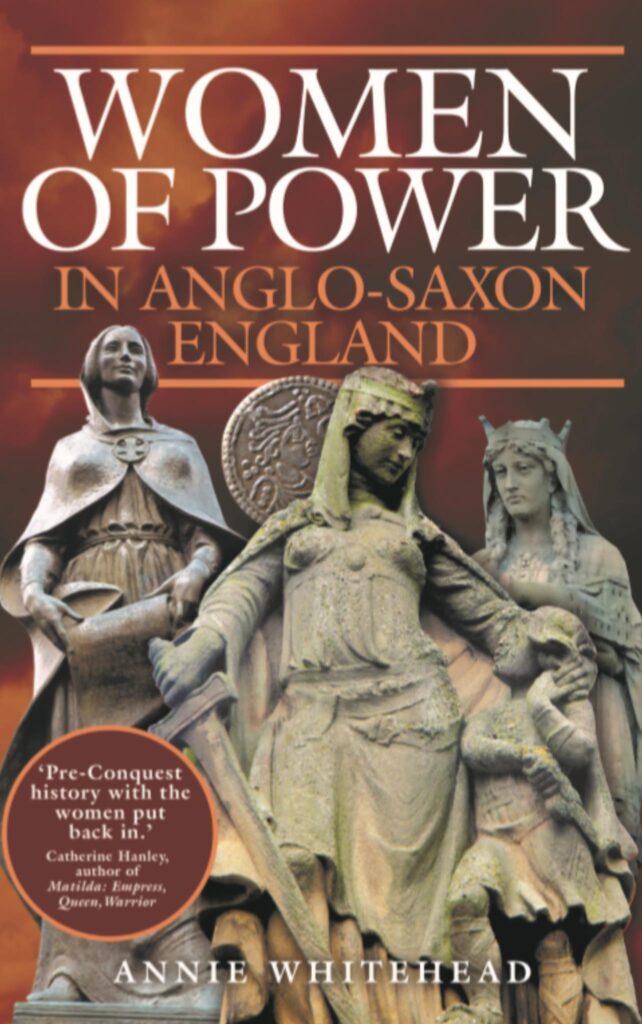 Many Anglo-Saxon kings are familiar. Æthelred the Unready is one, yet less is written of his wife, who was consort of two kings and championed one of her sons over the others, or his mother who was an anointed queen and powerful regent, but was also accused of witchcraft and regicide. A royal abbess educated five bishops and was instrumental in deciding the date of Easter; another took on the might of Canterbury and Rome and was accused by the monks of fratricide. Many Anglo-Saxon kings are familiar. Æthelred the Unready is one, yet less is written of his wife, who was consort of two kings and championed one of her sons over the others, or his mother who was an anointed queen and powerful regent, but was also accused of witchcraft and regicide. A royal abbess educated five bishops and was instrumental in deciding the date of Easter; another took on the might of Canterbury and Rome and was accused by the monks of fratricide.
Anglo-Saxon women were prized for their bloodlines – one had such rich blood that it sparked a war – and one was appointed regent of a foreign country. Royal mothers wielded power; Eadgifu, wife of Edward the Elder, maintained a position of authority during the reigns of both her sons. Æthelflaed, Lady of the Mercians, was a queen in all but name, while few have heard of Queen Seaxburh, who ruled Wessex, or Queen Cynethryth, who issued her own coinage. She, too, was accused of murder, but was also, like many of the royal women, literate and highly-educated.
From seventh-century Northumbria to eleventh-century Wessex and making extensive use of primary sources, Women of Power in Anglo-Saxon England examines the lives of individual women in a way that has often been done for the Anglo-Saxon men but not for their wives, sisters, mothers and daughters. It tells their stories: those who ruled and schemed, the peace-weavers and the warrior women, the saints and the sinners. It explores, and restores, their reputations.
Available to buy here: https://mybook.to/WomeninPower
To Be A Queen (Historical fiction)
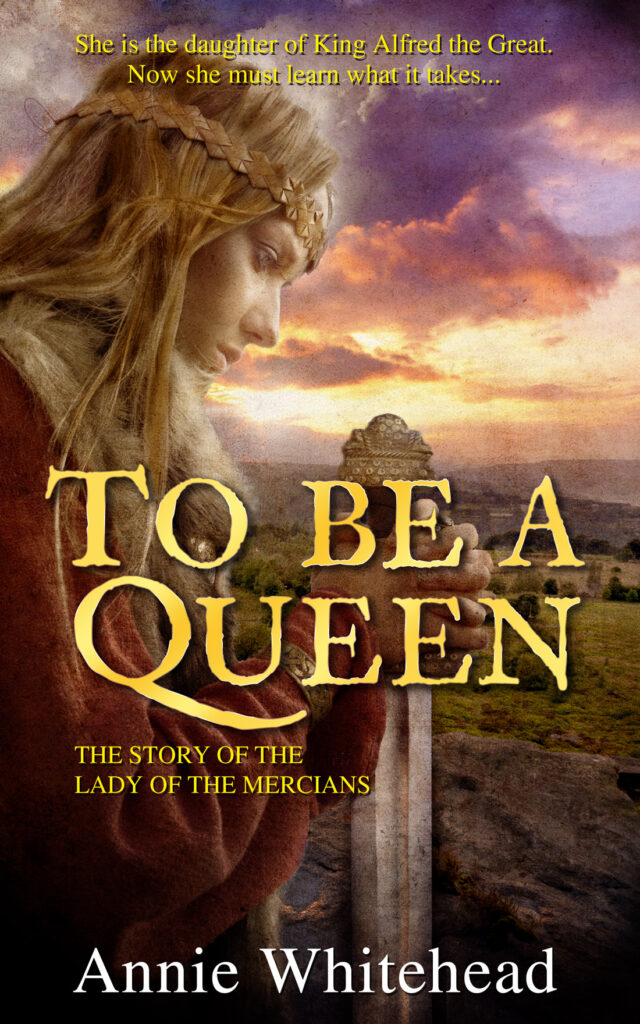 One family, two kingdoms, one common enemy … One family, two kingdoms, one common enemy …
This is the true story of Æthelflæd, the ‘Lady of the Mercians’, daughter of Alfred the Great. She was the only female leader of an Anglo-Saxon kingdom.
Born into the royal house of Wessex at the height of the Viking wars, she is sent to her aunt in Mercia as a foster-child, only to return home when the Vikings overrun Mercia. In Wessex, she witnesses another Viking attack and this compounds her fear of the enemy.
She falls in love with a Mercian lord but is heartbroken to be given as bride to the ruler of Mercia to seal the alliance between the two Anglo-Saxon kingdoms.
She must learn to subjugate her feelings for her first love, overcome her indifference to her husband and win the hearts of the Mercians who despise her as a foreigner and twice make an attempt on her life.
When her husband falls ill and is incapacitated, she has to learn to rule and lead an army in his stead. Eventually she must fight to save her adopted Mercia from the Vikings and, ultimately, her own brother.
To Be A Queen was Long-listed for HNS Indie Book of the Year 2016 and has been awarded an indieBRAG Gold Medallion.
Available to buy here: https://mybook.to/To-Be-A-Queen
Alison Morton is the author of Roma Nova thrillers – INCEPTIO, CARINA (novella), PERFIDITAS, SUCCESSIO, AURELIA, NEXUS (novella), INSURRECTIO and RETALIO, and ROMA NOVA EXTRA, a collection of short stories. Audiobooks are available for four of the series. Double Identity, a contemporary conspiracy, starts a new series of thrillers. JULIA PRIMA, Roma Nova story set in the late 4th century, starts the Foundation stories. The sequel, EXSILIUM, will be out in January 2024.
Find out more about Roma Nova, its origins, stories and heroines and taste world the latest contemporary thriller Double Identity… Download ‘Welcome to Alison Morton’s Thriller Worlds’, a FREE eBook, as a thank you gift when you sign up to Alison’s monthly email update. You’ll also be among the first to know about news and book progress before everybody else, and take part in giveaways.
If you enjoyed this post, do share it with your friends!Like this:Like Loading...
 Top row: David Penny, Clare Flynn, Liza Pratt, Anna Belfrage, Keith Dixon. Middle row: J J Marsh, Debbie Young, Antoine Banner, Elizabeth Buchan, Helen Hollick. Bottom row: Tony Riches, Jane Davis, E M Powell, Susan Grossey, Ruth Downie I like having guests on my writing blog. Unlike my thriller blog which is all about my books, their background and research, this writing blog is a warm, relaxing and random place where I and my guests can ramble on about writing and the writing life.
Many of the posts here are based on my experience over the past twelve years of writing seriously (and commercially), but a fair number feature guests. Although writing is solitary, getting your book out there is not – it’s teamwork.
Writers are lovely people – collaborative, knowledgeable, vastly experienced and with a GSOH. Without that humour, you’d be crying. Trust me on that.
But apart from all this warmth and togetherness, what are the harder reasons for hosting guests?
Brand awareness. Hosting engaging guest posts can establish a blog as worth reading. People will associate it with interesting content and expertise from a wide range of talent which means meaning they’ll (hopefully) think of you, not others.
Fresh content. Sometimes blogs can get a little repetitive and stale. (The fear felt by long-term bloggers like yours truly!) Bringing in guest bloggers introduces new, diverse content with different perspectives and styles. Of course, it must be relevant, hence lots of other writers and associated creative people on this blog.
Giving readers reliable information. I like to be viewed as somebody who knows one or two things about writing and publishing, as a possible source of information. I don’t think it’s an ego thing – more a case of giving back to others as a counterpoint to the help I received as a newbie author. But as I share knowledge beyond my own expertise, it may also give readers another reason to remain a subscriber. 😉
SEO. (No, I don’t really understand it either, but it seems to help.). Guest blogs can be a great way to boost Search Engine Optimisation and search engine rankings. By including good keywords and links, a site may be found by more potential readers. Page views and click-throughs go up.
Mutual back-scratching. Posting on other people’s blogs lifts both host’s and guest’s visibility and increases the sense of helping each other’s careers. (Possibly an ego thing…) Additionally, most guests can’t resist the temptation to promote their guest posts. It makes them look good. They can post to social media and run an announcement on their own blog.
Practical stuff
Pitches and invitations. Generally, I don’t accept pitches except from authors I know or know about. We all get the crypto-currency, gold investment and sunglasses sellers pitching and they go straight in the bin.
I invite people who I think will provide something interesting, informative and/or fun related to books, writing and the writing life in the widest sense. I don’t accept sales posts or disguised sales posts, but I always post the author’s latest book at the end with a link. Click-bait is deeply discouraged.
Ah, links. Yes, a few general links to social media are fine, but not every single one to every retail site in the universe.
Tone and style. Guests should write coherently – not over-academically, but not unintelligibly either. I will correct punctuation, but not alter how and why they are saying something – it’s their post, after all!
Add 0ns. Apart from their piece, I post a bit of bio (I like to know how they tick and what they’ve done.), the blurb for their latest book, and photos – them, their cover, landscapes, artefacts, costumes, coins, maps, etc. My readers like pictures…
What’s coming in the next few weeks?
You may have noticed a book called Historical Stories of Exile has just been published. I contributed a story, ‘My Sister’ to it, a side story to EXSILIUM, a Roma Nova Foundation story set in AD 395. I invited the other contributing authors to write a guest post about the background to their story, but not a sales-y piece. I wanted to get behind the story and their motivation for writing it.
I hope you’ll be as fascinated by their posts as I am!
Alison Morton is the author of Roma Nova thrillers – INCEPTIO, CARINA (novella), PERFIDITAS, SUCCESSIO, AURELIA, NEXUS (novella), INSURRECTIO and RETALIO, and ROMA NOVA EXTRA, a collection of short stories. Audiobooks are available for four of the series. Double Identity, a contemporary conspiracy, starts a new series of thrillers. JULIA PRIMA, Roma Nova story set in the late 4th century, starts the Foundation stories. The sequel, EXSILIUM, will be out in February 2024.
Find out more about Roma Nova, its origins, stories and heroines and taste world the latest contemporary thriller Double Identity… Download ‘Welcome to Alison Morton’s Thriller Worlds’, a FREE eBook, as a thank you gift when you sign up to Alison’s monthly email update. You’ll also be among the first to know about news and book progress before everybody else, and take part in giveaways.
If you enjoyed this post, do share it with your friends!Like this:Like Loading...
|
Subscribe to Blog via Email
Join 51 other subscribers.
Categories
Archive
|
 I’m delighted to welcome Amy Maroney back to the blog to talk about being in ‘Exile’. Amy studied English Literature at Boston University and worked for many years as a writer and editor of nonfiction. She lives in Oregon, U.S.A. with her family. When she’s not diving down research rabbit holes, she enjoys hiking, dancing, traveling, and reading.
I’m delighted to welcome Amy Maroney back to the blog to talk about being in ‘Exile’. Amy studied English Literature at Boston University and worked for many years as a writer and editor of nonfiction. She lives in Oregon, U.S.A. with her family. When she’s not diving down research rabbit holes, she enjoys hiking, dancing, traveling, and reading. 

























